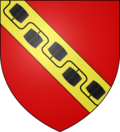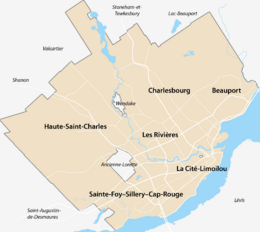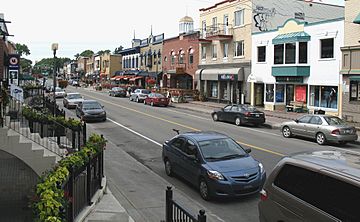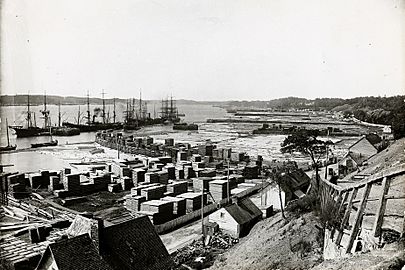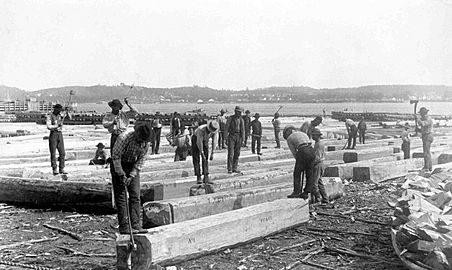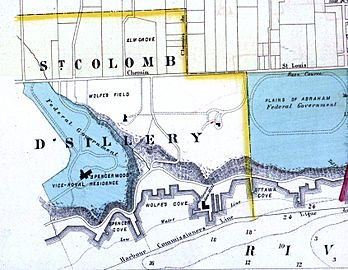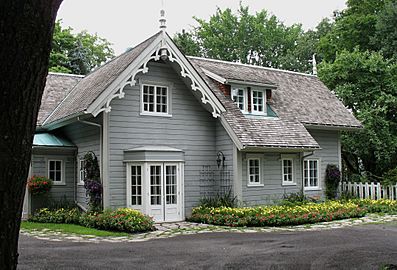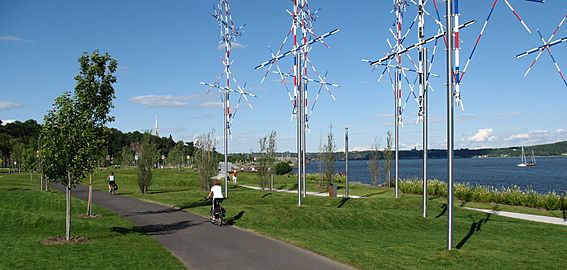Sillery, Quebec City facts for kids
Quick facts for kids
Sillery
|
||
|---|---|---|
|
District (French: quartier)
|
||
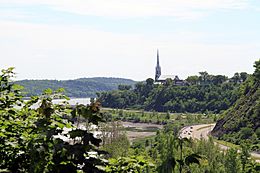
|
||
|
||
| Etymology: Noël Brûlart de Sillery | ||
| Motto(s):
Latin: Non multa sed multum (Not many things but much)
|
||
| Country | ||
| Province | ||
| City | ||
| Founded | 1637 | |
| District of Sainte-Foy–Sillery | 1 January 2002 | |
| District of Sainte-Foy–Sillery–Cap-Rouge | 1 November 2009 | |
| Founded by |
|
|
| Government | ||
| • Body | Conseil de quartier | |
| Area | ||
| • Total | 755 ha (1,866 acre) | |
| Elevation | 72 m (236 ft) | |
| Population
(2016)
|
||
| • Total | 13,570 | |
| • Density | 1,797.4/km2 (4,655/sq mi) | |
| Demonym(s) | Sillerois(e) | |
| Time zone | UTC−05:00 (EST) | |
| • Summer (DST) | UTC−04:00 (EDT) | |
| Postal Code FSA |
G1S
|
|
| Area codes | 418, 581, 367 | |
| Website | ||
Sillery is a district in Quebec City, Quebec, Canada. It was once its own independent city, founded way back in 1637. Sillery is now one of 35 areas that make up Quebec City.
On January 1, 2002, Sillery joined with Quebec City as part of a big change across Quebec. This meant many smaller towns became part of larger cities. Sillery is now part of the borough called Sainte-Foy–Sillery–Cap-Rouge. Quebec City has six of these boroughs in total.
Sillery is home to an important historical area called the Sillery Heritage Site. This site was recognized by the government in 1964. Later, in 2006, the Canadian government also added it to the Canadian Register of Historic Places. This means it's a special place that helps tell Canada's story.
The City of Quebec has 27 neighbourhood councils. Sillery has its own council, called le conseil de quartier de Sillery. This council holds public meetings about once a month at the community centre. These meetings allow local citizens to have a say in their community. The council has 10 members who are elected for different terms.
Contents
History of Sillery
Sillery is named after Noël Brûlart de Sillery (1577–1640). He was a rich French diplomat and a Knight of Malta. He later became a Catholic priest and gave money to start a settlement in 1637–1638. This settlement was for First Nations people who became Catholic.
Early Settlement and Challenges
The community was built near a cove where the Algonquin people used to gather in summer to fish for eels. It was first named in honor of Saint Joseph. In the Algonquin language, it was called Kamiskouaouangachit. Up to 40 Algonquin Christian families lived there most of the year. They only left during hunting season.
This settlement started because the Algonquin people were interested in farming. Many also converted to Christianity. There was also pressure from the ongoing Beaver Wars. Some Algonquin people from as far away as the Ottawa River valley came to live here.
Missionaries like Jacques Gravier came to New France. They lived with the people in Sillery to learn their languages. This helped them communicate before going to other settlements. By the early 1700s, Gravier had created a large dictionary of the Kaskaskia Illinois–French language.
In 1640, a group of Augustinian sisters started a convent in Sillery. This convent offered a place for temporary residents. It was especially helpful for people escaping the Beaver War or for seasonal visitors in winter. Sadly, many of the native people in the community got sick from new infectious diseases. They had no natural protection against these illnesses. By the late 1680s, most of the settlement was empty.
Sillery as a Lumber Port
The town was later renamed Sillery to honor Noël Brûlart de Sillery, who funded it. It became an important port for the lumber industry. The city of Sillery's motto was non multa sed multum. This Latin saying means "not many things, but much." It was a good description for the small but important area.
The community grew from the water's edge up to the high ground overlooking the Saint Lawrence River. This area included Anse-au-Foulon. This is where General Wolfe's army landed in 1759 during the Battle of the Plains of Abraham. His army successfully captured Quebec City. In 1760, during the French and Indian War, the Battle of Sainte-Foy was fought near Sillery. This was when the French tried to take back Quebec City.
Bois-de-Coulonge Park
Sillery is home to Bois-de-Coulonge Park. This park was once the official residence for Quebec's Lieutenant-Governors. A large house called Spencer Wood was built there in 1854. The Quebec Government bought it in 1870. It served as the Lieutenant-Governor's home until a big fire destroyed the main building in 1966.
The estate was first named Spencer Wood in 1815. It honored Spencer Perceval, a British Prime Minister. In 1950, it was renamed Bois-de-Coulonge.
Today, Sillery is known for its quiet, tree-lined streets. It also has historic churches like Saint-Michel de Sillery Church. You can also find great views of the river and several old schools run by religious groups.
Sillery Today
As of January 1, 2002, Sillery became part of Quebec City. It is now a district within the Sainte-Foy—Sillery—Cap-Rouge Borough.
Sillery is known for being a diverse area. In 2006, about 5% of its residents spoke English as their first language. About 5.75% spoke other languages besides French or English. This is higher than the average for the wider Quebec City area.
Sillery is also one of the wealthiest areas in Quebec City. In 2017, homes there sold for an average of CA$570,000. Many professors from nearby Laval University live here. However, there are still some smaller, more affordable apartment buildings in the area.
According to Quebec's statistics agency, in 2001, the average income for households in Sillery was CA$113,091. About 58% of households earned more than CA$80,000 per year. These were the highest figures in the Capitale-Nationale region. In 2012, the average personal income was CA$55,645, which was still the highest in the Quebec City region.
Sillery Population Facts
The city of Sillery became part of Quebec City in 2002. However, Statistics Canada still collected information about the area. Here are some facts from the 2016 Canadian Census:
- Population: 13,570
- Number of homes: 5,625
- Average household size: 2.3 people
- Median household income (for 2015): CA$149,206
- Percentage of Canadian citizens: 90.2%
- Population over 15 without a high school diploma: 6.1%
Gallery
See also
 In Spanish: Sillery (Québec) para niños
In Spanish: Sillery (Québec) para niños


